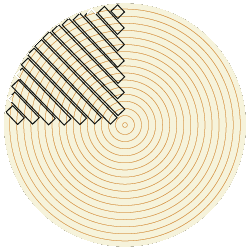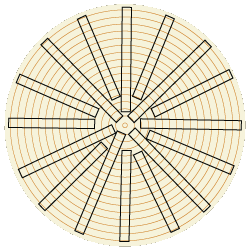Unlocking the Grain: How Log Cuts Reveal the Beauty Within
When it comes to woodworking, few things are as satisfying as uncovering the hidden patterns inside a rough log. But did you know that how you cut that log makes all the difference? From wild, wavy figures to clean, straight lines, the orientation of the cut determines the look, stability, and character of your final piece.
In this article, I’ll walk you through the most common methods of cutting a log—and the grain patterns they reveal.
1. Plain Sawn (Flat Sawn)
Plain sawing is the most commonly used method in both commercial and hobbyist woodworking. It’s fast, efficient, and makes the most of a log's width, which is why it’s often seen in construction timber, flooring, and inexpensive furniture.
The saw cuts parallel to the growth rings, starting from one side of the log and working through to the other. This means the angle between the growth rings and the face of the board is usually less than 45°.
Grain Pattern: Recognisable by its arched or “cathedral” grain pattern across the face of the board, especially towards the centre.
Pros:
Maximises yield – more usable wood per log
Produces wider boards
Quicker and cheaper to process
Cons:
Boards are more prone to cupping and warping as they dry or respond to humidity changes
Less consistent grain can make matching difficult
Surface wear is less predictable in high-use areas
Plain-sawn wood is ideal when cost and board width matter more than stability—great for shelving, cladding, or decorative features where movement isn’t a major concern.
2. Quarter Sawn
Quarter sawing starts by cutting the log into four equal sections (like a pie), then slicing boards perpendicular to the growth rings from each quarter. This method results in growth rings that are typically between 60–90° to the face of the board.
This orientation gives the wood a tighter, more linear grain appearance and brings out medullary rays—those shimmering, reflective flecks you often see in species like oak, sycamore, and London Plane.
Grain Pattern: Clean, straight grain with occasional beautiful flecking or ray patterns depending on species.
Pros:
Greater dimensional stability (less likely to warp or twist)
More resistant to moisture movement
Visual appeal – particularly when medullary rays are prominent
Cons:
Higher cost due to more labour and waste
Boards are narrower, which can be limiting for wide projects
Not as widely available in all species
3. Rift Sawn
Rift sawing is a precise but inefficient method where each cut is made at a consistent angle, typically 30–60°, to the growth rings. Unlike quarter sawn boards, rift sawn cuts aim to avoid medullary rays, focusing instead on creating a completely uniform, vertical grain appearance.
Because of the angle and the need to rotate the log between cuts, rift sawn lumber generates the most waste and is usually the most expensive.
Grain Pattern: Very consistent and linear with no arched patterns or ray flecking—just straight, vertical lines.
Pros:
Cleanest and most uniform grain – ideal for fine furniture, cabinetry, or architectural millwork
Excellent stability and strength
Easy to match multiple boards visually
Cons:
High waste – much of the log becomes offcut
Narrow boards and higher cost
Rare to find in larger quantities or exotic woods
Rift sawn wood is a favourite in high-end chair and table legs where matching grain and minimal movement is essential.
4. Live Sawn (Through & Through)
Also called “through sawn,” live sawing involves cutting straight through the log from end to end without rotating it. This approach produces boards with a natural mix of plain, rift, and quarter sawn grain across each board, depending on where the cut falls in the log.
Live sawn lumber is increasingly popular in modern sawmills and with makers who appreciate character and efficiency. It also retains the natural taper and shape of the log more fully.
Grain Pattern: A natural blend—plain sawn in the centre (with cathedral grain), quarter sawn further out, and rift-like grain near the edges.
Pros:
Efficient use of material, with very little waste
Wide, full-length boards with a natural, rustic look
Economical in both time and material cost
Cons:
Mixed grain types can be visually inconsistent
Greater movement and warping in plain-sawn areas
More complex drying process due to varying grain orientations
Live sawn is ideal for large slabs, rustic tabletops, or turning blanks where a mix of grain can add unique character.
Why It Matters
Choosing how a log is cut isn’t just about aesthetics—it affects the movement, strength, and workability of the wood. For turners and furniture makers alike, understanding this can take your projects to the next level.




